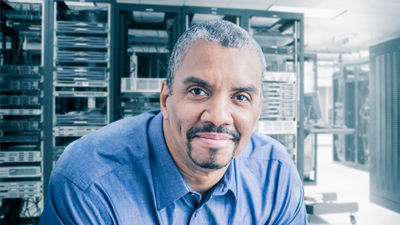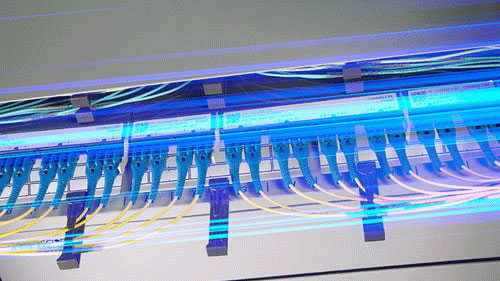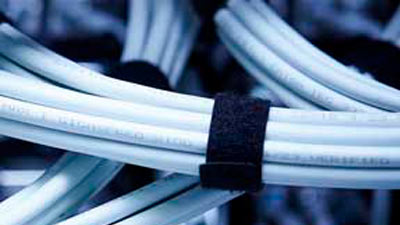
您是否准备好应对AI和带宽需求巨大的应用对您的数据中心产生的影响?
Read our new 2024 Data Center trends eBook to know what’s coming next and how you can prepare for it.
Written by CommScope’s world class team of data center specialists, our new 8-chapter eBook is designed to help you learn about and anticipate the big issues that will impact data centers in 2024 and beyond. What to know about AI in the data center, how footprints are growing past national borders and what to do about it, understanding and managing data sovereignty, and much more. Plus cabling, connectivity and components in architecture and where to site data centers to get the maximum performance and results. Our new eBook provides tips, insights and recommendations to help you overcome new and existing challenges and drive business value from your data center.
Meeting the demands of ever-increasing capacity is challenging. The ability to support higher data rates, port counts and fiber density is key. You need more fibers in place – so how can you ensure you deliver on capacity with only so much space to play with?
High density solutions that make more of precious space are helping transform data centers so you can continue providing great customer experience. Advances like smaller cables that pack in more fibers and new smaller connectors that support higher fiber counts are enabling data centers handle increasing demands for bandwidth, capacity, and lower latency.
Transceiver innovation continues at a fast pace and the ability to adapt is crucial as increasing demands for bandwidth, capacity, and lower latency drive migration to faster network speeds. As you consider which optical technology is right for your networks, this chapter breaks down the options of 400G, 800G and 1.6T optical transceivers and how that choice impacts the fiber cable and connectors needed in the data center.
Every data center operator, regardless of size, has one thing in common: power—how to get it and how to conserve it. Efficiency isn’t the only watchword for power in data centers – there are challenges in terms of power supply issues, politics and social demography to overcome too.
The decision of where to build the data center is governed as much by these external factors as it is by the operator’s business strategy. In this chapter, we’ll explore these three primary factors that can challenge an organization’s plans when it comes to power.
Understanding data sovereignty is essential to successful operations: due to its significant impact on your operations. Around the world there are many data sovereignty laws and regulations already in place. When making decisions as to where to locate a new facility, companies must account for the local regulations and how they affect where data can be stored and processed.
Building a data center infrastructure able to support data sovereignty is essential but not impossible. Success hinges on being able to incorporate flexibility into the physical infrastructure to ensure it can support future topologies and data rates for the next generation of servers and switches.
Enabling the type of application connectivity, bandwidth and latency performance needed to keep pace with society’s demands requires geographic diversity, capacity and accessibility on a massive scale. Service providers are responding by continuing to build out data centers of various types and sizes and investing in more interconnect networks to create more capacity and lower latency.
At first glance, the continued buildout of new ICT network infrastructure would appear to be in direct opposition to our goal of environmental sustainability. But this is not necessarily the case. In this chapter, we’ll show how CommScope is successfully balancing the growth of data center capacity and the greening of our planet.
随着网络计划迁移至 5G 和物联网,IT 经理开始关注边缘,并且需要将更多容量和处理能力部署在更靠近最终用户的位置。在此过程中,他们将会重新评估数据中心的作用。 In an IoT-empowered world, the importance of AI and ML cannot be understated. Neither can the role of the data center in making it happen.
Digitization is driving more traffic to more data centers across the network and between enterprise data centers, disaster recovery locations, and eventually to multiple cloud peering points. To maintain good quality of service, traffic needs to be sent across the campus and out into the cloud rapidly and securely.
Therefore, Data Center Interconnect (DCI) has become essential, as data centers no longer exist as individual and isolated islands but are now part of a highly interconnected ecosystem. Selecting the right DCI infrastructure, architecture and topology depends on a wide range of variables. In this chapter we look at some of the developments that may figure into your decision.
There are huge possibilities to be had from AI: but making the most of them starts with getting the fundamentals right. Is your cabling infrastructure ready for what’s coming?
AI is the main driver for current and future data center growth, but AI clusters have unique data processing requirements and thus require a new data center architecture. Careful consideration of the AI cluster cabling will help save cost, power, and installation time.
This chapter outlines some of the key challenges and opportunities of cabling AI data centers, along with a few best practices and tips for success. The right fiber cabling will enable organizations to fully benefit from artificial intelligence.






